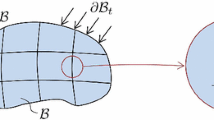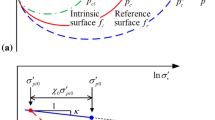Abstract
The method of vertical lines in the case of quasi-static solid mechanics applying constitutive models of evolutionary-type yields after the spatial discretization by means of finite elements a system of differential-algebraic equations. It is of substantial interest how fast, accurate, and stable such computations can be carried out. Moreover, the questions are how simple the implementation can be done and how susceptible a procedure is to programming errors. In this article, this is investigated for half-explicit Runge–Kutta methods that are applied to small and finite strain viscoelasticity. The advantage of the method is given by a non-iterative scheme on element level. Additionally, it turns out that for models where linear elasticity is one ingredient in the constitutive model, the method leads to only one required LU-decomposition at the beginning of the entire computation, and in each time step, only one back-substitution step has to be carried out. This outperforms current finite element computations. Order investigations of various integration schemes and the automatic step-size behavior are studied. This new proposal is compared to a classical Backward-Euler implementation, high-order stiffly accurate diagonally implicit Runge–Kutta, and recently proposed Rosenbrock-type methods. Advantages and disadvantages of the applied schemes are discussed.
Similar content being viewed by others
References
Alexander R.: Diagonally implicit Runge–Kutta methods for stiff O.D.E.’s. SIAM J. Numer. Analy. 14, 1006–1021 (1977)
Arnold M.: Half-explicit Runge–Kutta methods with explicit stages for differential-algebraic systems of index 2. BIT 38(3), 415–438 (1998)
Arnold M., Strehmel K., Weiner R.: Half-explicit Runge–Kutta methods for semi-explicit differential-algebraic equations of index 1. Numer. Math. 64, 409–431 (1993)
Beyn W., Thummler V.: Freezing solutions of equivariant evolution equations. SIAM J. Appl. Dyn. Syst. 3(2), 85–116 (2004)
Birken, P., Quint. K.J., Hartmann, S., Meister, A.: A time-adaptive fluid-structure interaction method for thermal coupling. Comput. Vis. Sci. (2011). doi:10.1007/s00791-010-0150-4:1-10
Bogacki, P, Shampine, L.F.: A 3(2) pair of Runge–Kutta formulas. Appl. Math. Lett. 2, 321–325 (1989)
Cash J.R.: Diagonally implicit Runge–Kutta formulae with error estimates. J. Inst. Math. Appl. 24, 293–301 (1979)
Diebels S., Ellsiepen P., Ehlers W.: Error-controlled Runge–Kutta time integration of a viscoplastic hybrid two-phases model. Tech. Mech. 19, 19–27 (1999)
Dormand J.R., Prince P.J.: A family of embedded Runge–Kutta formulae. J. Comput. Appl. Math. 6, 19–26 (1980)
Eckert S., Baaser H., Gross D., Scherf O.: A BDF2 integration method with stepsize control for elastoplasticity. Comput. Mech. 34(5), 377–386 (2004)
Ellsiepen, P.: Zeit- und ortsadaptive Verfahren angewandt auf Mehrphasenprobleme poröser Medien. Doctoral thesis, Institute of Mechanics II, University of Stuttgart, report No. II-3 (1999)
Ellsiepen P., Hartmann S.: Remarks on the interpretation of current non-linear finite-element-analyses as differential-algebraic equations. Int. J. Numer. Methods Eng. 51, 679–707 (2001)
Fritzen, P.: Numerische Behandlung nichtlinearer Probleme der Elastizitäts- und Plastizitätstheorie. Doctoral thesis, Department of Mathematics, University of Darmstadt (1997)
Hairer E., Wanner G.: Solving Ordinary Differential Equations II. Springer, Berlin (1996)
Hairer E., Lubich C., Roche M.: The Numerical Solution of Differential-Algebraic Systems by Runge-Kutta Methods. Springer, Berlin (1989)
Hairer E., Norsett S.P., Wanner G.: Solving Ordinary Differential Equations I, 2nd edn. Springer, Berlin (1993)
Hamkar, A.W., Hartmann, S., Rang, J.: A stiffly accurate Rosenbrock-type method of order 2. Appl. Numer. Math. (2010) (in review)
Hartmann S.: Computation in finite strain viscoelasticity: finite elements based on the interpretation as differential-algebraic equations. Comput. Methods Appl. Mech. Eng. 191(13–14), 1439–1470 (2002)
Hartmann S.: A remark on the application of the Newton–Raphson method in non-linear finite element analysis. Comput. Mech. 36(2), 100–116 (2005)
Hartmann S.: A thermomechanically consistent constitutive model for polyoxymethylene: experiments, material modeling and computation. Arch. Appl. Mech. 76, 349–366 (2006)
Hartmann S., Bier W.: High-order time integration applied to metal powder. Int. J. Plast. 24(1), 17–54 (2008)
Hartmann S., Bier W.: High-order time integration applied to metal powder plasticity. Int. J. Plast. 24(1), 17–54 (2008)
Hartmann S., Hamkar A.W.: Rosenbrock-type methods applied to finite element computations within finite strain viscoelasticity. Comput. Methods Appl. Mech. Eng. 199(23–24), 1455–1470 (2010)
Hartmann S., Haupt P.: Stress computation and consistent tangent operator using non-linear kinematic hardening models. Int. J. Numer. Methods Eng. 36, 3801–3814 (1993)
Hartmann S., Neff P.: Polyconvexity of generalized polynomial-type hyperelastic strain energy functions for near-incompressibility. Int. J. Solids Struct. 40(11), 2767–2791 (2003)
Hartmann S., Wensch J.: Finite element analysis of viscoelastic structures using Rosenbrock-type methods. Comput. Mech. 40, 383–398 (2007)
Hartmann S., Lührs G., Haupt P.: An efficient stress algorithm with applications in viscoplasticity and plasticity. Int. J. Numer. Methods Eng. 40, 991–1013 (1997)
Hartmann S., Quint K.J., Arnold M.: On plastic incompressibility within time-adaptive finite elements combined with projection techniques. Comput. Methods Appl. Mech. Eng. 198, 178–193 (2008)
Hartmann S., Quint K.J., Hamkar A.W.: Displacement control in time-adaptive non-linear finite-element analysis. J. Appl. Math. Mech. 88(5), 342–364 (2008)
Hartmann S., Duintjer Tebbens J., Quint K.J., Meister A.: Iterative solvers within sequences of large linear systems in non-linear structural mechanics. J. Appl. Math. Mech. (ZAMM) 89(9), 711–728 (2009)
Hiley R.A., Rouainia M.: Explicit Runge–Kutta methods for the integration of rate-type constitutive equations. Comput. Mech. 42(1), 53–66 (2008)
Hoyer W., Schmidt J.W.: Newton-type decomposition methods for equations arising in network analysis. ZAMM Zeitschrift für Angewandte Mathematik und Mechanik 64, 397–405 (1984)
Lion A.: On the large deformation behaviour of reinforced rubber at different temperatures. J. Mech. Phys. Solids 45, 1805–1834 (1997)
Liu C.H., Hofstetter G., Mang H.A.: 3d finite element analysis of rubber-like materials at finite strains. Eng. Comput. 11, 111–128 (1994)
Lubliner J.: A model of rubber viscoelasticity. Mech. Res. Commun. 12, 93–99 (1985)
Lührs G., Hartmann S., Haupt P.: On the numerical treatment of finite deformations in elastoviscoplasticity. Comput. Methods Appl. Mech. Eng. 144, 1–21 (1997)
Murua A.: Partitioned half-explicit Runge–Kutta methods for differential-algebraic systems of index 2. Computing 59(1), 43–61 (1997)
Rabbat N.B.G., Sangiovanni-Vincentelli A.L., Hsieh H.Y.: A multilevel Newton algorithm with macromodeling and latency for the analysis of large-scale nonlinear circuits in the time domain. IEEE Trans. Circuits Syst. 26, 733–740 (1979)
Rang, J., Angermann, L.: New Rosenbrock methods of order 3 for PDAEs of index 2. In: Proceedings of Equadiff, 11, pp 385–394. (2005)
Schenk O., Gärtner K.: Solving unsymmetric sparse systems of linear equations with Pardiso. Future Gener. Comput. Syst. 20(3), 475–487 (2004). doi:10.1016/j.future.2003.07.011
Scherf, O.: Numerische Simulation inelastischer Körper. Fortschritt-Berichte VDI, Reihe 20 (Rechnerunterstützte Verfahren) Nr.321, VDI-Verlag, Düsseldorf (2000)
Schropp J.: Geometric properties of Runge–Kutta discretizations for index 2 differential algebraic equations. SIAM J. Numer. Anal. 40(3), 872–890 (2003)
Simo J.C., Taylor R.L.: Consistent tangent operators for rate-independent elastoplasticity. Comput. Methods Appl. Mech. Eng. 48, 101–118 (1985)
Simo J.C., Taylor R.L.: Quasi-incompressible finite elasticity in principal stretches. Continuum basis and numerical algorithms. Comput. Methods Appl. Mech. Eng. 85, 273–310 (1991)
Simo J.C., Taylor R.L., Pister K.S.: Variational and projection methods for the volume constraint in finite deformation elasto-plasticity. Comput. Methods Appl. Mech. Eng. 51, 177–208 (1985)
Sofroniou M., Spaletta G.: Construction of explicit Runge–Kutta pairs with stiffness detection. Math. Comput. Model. 40, 1157–1169 (2004)
Strehmel K., Weiner R.: Numerik gewöhnlicher Differentialgleichungen. Teubner Verlag, Stuttgart (1995)
Wittekindt, J.: Die numerische Lösung von Anfangs-Randwertproblemen zur Beschreibung inelastischen Werkstoffverhaltens. Doctoral thesis, Department of Mathematics, University of Darmstadt (1991)
Author information
Authors and Affiliations
Corresponding author
Rights and permissions
About this article
Cite this article
Rothe, S., Hamkar, AW., Quint, K.J. et al. Comparison of diagonal-implicit, linear-implicit and half-explicit Runge–Kutta methods in non-linear finite element analyses. Arch Appl Mech 82, 1057–1074 (2012). https://doi.org/10.1007/s00419-012-0617-5
Received:
Accepted:
Published:
Issue Date:
DOI: https://doi.org/10.1007/s00419-012-0617-5




